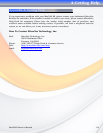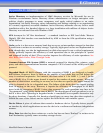
MaxNAS Owner’s Manual
71
Disk Array A Disk Array is a logical disk comprised of multiple physical hard disks. The number
of hard disks in an disk array is dictated by the type of the array and the number of spares that
may be assigned to it. Furthermore, whether a disk array can be built using part of the space on
a disk (as opposed to being forced to use the whole disk) depends upon the implementation.
Disk Arrays are typically used to provide data redundancy and/or enhanced I/O performance.
Disk Block Data is stored on disks in blocks that are generally of a predefined size. This size
is typically a value such as 512 bytes, 1 KB, 2 KB, etc. When a record is written to a disk, the
blocks used for that record are dedicated to storing the data for that record only. In other
words two records are not permitted to share a block. Consequently, a block may be only
partially used. For instance, assume a disk has a block size of 1 KB and a user record written
to it has a size of 3148 bytes. This implies that the user record will be written into 4 blocks,
with the contents of one of the blocks being only partially filled with (3148 – 3072) 76 bytes
of data.
DNS (Domain Name Server) A system that stores information associated with domain names
in a distributed database on networks, such as the Internet. The domain name system (domain
name server) associates many types of information with domain names, but most importantly,
it provides the IP address associated with the domain name. It also lists mail exchange servers
accepting e-mail for each domain. In providing a worldwide keyword-based redirection
service, DNS is an essential component of contemporary Internet use.
Dynamic Host Configuration Protocol (DHCP) a client-server networking protocol. A
DHCP server provides configuration parameters specific to the DHCP client host requesting,
generally, information required by the client host to participate on an IP network. DHCP
also provides a mechanism for allocation of IP addresses to client hosts. DHCP emerged as a
standard protocol in October 1993.
Ethernet A local-area network standard that is currently the most prevalent with an estimated
80% of desktops connected using this standard. It was developed jointly by Xerox, DEC and
Intel and employs a bus or star topology.
File System A file system is a layer between applications and the disks to which their I/O
is directed. File systems serve to hide the details of the physical layout of files on the disk,
allowing applications to address files as a contiguous logical area on disk accessible by a
name regardless of their physical location on the storage device.
FTP (File Transfer Protocol) is a commonly used, open standard protocol for exchanging
files over any network that supports the TCP/IP protocol (such as the Internet or an intranet).
Virtually every computer platform supports the FTP protocol. This allows any computer
connected to a TCP/IP based network to manipulate files on another computer on that network
regardless of which operating systems are involved (if the computers permit FTP access.)
There are many existing FTP client and server programs, and many of these are free.
Hot Spare One or more disks in a RAID array may fail at any given time. In fact, all RAID
types with the exception of RAID 0 provide methods to reconstruct the array in the event of
such an occurrence. A commonly used tactic is to earmark a hard disk that is not being used
E-Glossary


















